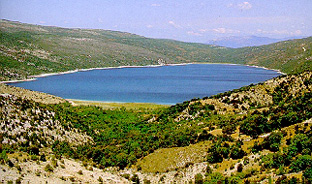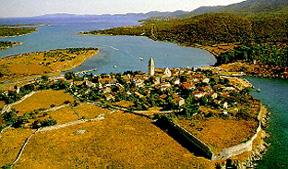|
|
APSYRTIDES - Where are these islands?Zvonko Springer,
Salzburg, Austria, 1999
You find these wondrous islands at northern part of the Adriatic and next to the harbor of RIJEKA. The CRES-LOSINJ island group consists of a 'necklace' of about thirty islands, islets and reefs situated in the northern Adriatic, between KVARNER and the Kvarneric region, within the reach of Central Europe. These islands are the remains of relief elevations from the Pleistocene period, and the channels between them are flooded valleys. A bridge in OSOR connects the islands of Cres and Losinj, which in the distant past were actually one island. Here's the story of APSYRTIDES name's origin.
 Areial view map of North Adriatic Island - designed by Roberto Kersulic for JADRANKA HIT d.d., HR-51550 MALI LOSINJ According an ancient legend the King AETES from Kolchys owned a Golden Fleece. JASON, a young and brave warrior got hold of this Fleece in using all his shrewdness and magician's helps too. Of course, King's daughter MEDEA fell in love with Jason and helped him in his endeavor. Medea cheated her father to find out he keeps the Fleece. She gets hold of the Fleece and fled with Jason on his ship ARGO. The treacherous couple was helped by the ARGONAUTS who were Jason's comrades on many voyages. King Aetes' son APSYRTES sailed of in pursuit of the villainous couple. Soon he saw ship's sails and closed in rapidly calling his sister's name asking her to give back the Fleece. Medea lured her brother to come on board of Argo to get the Fleece. Apsyrtides was ambushed by Jason and killed in the most meanly way. Medea cut her brother's body into many pieces and threw his limbs and other parts into the sea. Out of these many body parts new islands emerged known now a days as the APSYRTIDES.
 The WHITEHEADED EAGLE nesting and living on the island CRES and the biggest colony in this part of Europe - from Ana Ivelja-Dalmatin's book CROATIAN ADRIATIC ISLANDS, published by "Laurana" & "Trsat" in Zagreb 1996 You'd find these many islands at the northern Adriatic Sea which names are CRES (Chersso, ital.), PLANIK, LOSINJ (Lussin), UNIJE, SRAKANE, SUSAK (Sanssego - search for the name in US) and ILOVIK. I haven't mentioned few smaller body parts. Now, you know where APSYRTIDES islands are and how they have been created some 25,000 years ago. The main island of them was named OSOR at those times what is now know as the CRES and LOSINJ archipelago. Its total length is about 99 kilometers from northwest to southeast. Their total area of the many islands amounts to about 501 sq. kilometers. The 45th parallel goes through the islands, which has a positive effect on the climate and the way of life on these islands. The possibilities for sailing along the coasts of Apsyrtides archipelago are fantastic and ensured by constant winds. It has been known as the Promised Land for seafarers since ages.
 The VRANA LAKE on island Cres - from Branko Fucic's book At the upper end of the archipelago is the island CRES on which the VRANSKO LAKE is a natural rarity. It is a crypto-depression with a maximum depth of 61,5 m under the sea level. This is a freshwater lake and its surface level is in average 13 m above the sea level (!). It provides the islands with sufficient amounts of drinking water over the entire year. Due to their mild climate, the settlements of VELI and MALI LOSINJ were proclaimed climatic health resorts in 1892. They are rich in pine forests, planted thanks to the efforts of natural scientist Ambroz Haracic.
 Sculputre "BLIND LUTE PLAYERES" near the Cathedral in Osor on Cres - from Ana Ivelja-Dalmatin's book CROATIAN ADRIATIC ISLANDS The oldest Colonies on islands, such as OSOR, LUBENICE, CRES, BELI and USTRINE, are rich in historical palaces and churches, and their treasuries contain important paintings, sculptures and other valuables. There is an archaeological and sacral collection in Cres and an archaeological collection in Osor. A collection of Glagolitic stone monuments is situated in VALUN. The Baroque basilica in Veli Losinj and the votive church on Cikat are famous, as well as other culturally and historically interesting sites. The oldest treasures of the island group are Beli, Cres, Lubenice (known as "Stone town" too) and Osor, with their characteristic architectural forms, narrow streets and wide squares with the remains of town walls. There are elements of local construction styles, as well as the Gothic, Renaissance and Baroque styles. OSOR is town is the oldest of some 4.000 years on the archipelago and hosts musical festivals and exhibitions of arts every year now.
 Panaroma view of LUBENICE alias the "Stone town" on island Cres - from Branko Fucic's book APSYRTIDES, 2nd Edition Mali Losinj 1995 A great natural diversity in such a small area can be seen in hundred year-old forests of Aleppo pine, thousands of autochthonous plant species as well as numerous medicinal and aromatic herbs of the Mediterranean climate (rosemary and predominately garden-sage). Around the town of Cres, there are vast groves of assorted olives, symbolizing the eternal struggle for life on the island. The island of Losinj is overgrown by Evergreen Holm oak, Aleppo pine, strawberry trees and laurel trees. There are also high eucalyptuses, locusts, agaves, palms and lemon, orange and tangerine trees. Griffon vultures (Gyps fulvus) nest on the cliffs of a natural reserve of the island of Cres since 10.000 years. These birds are the last examples of this species in Europe. A historical and cultural mosaic produced over several millennia in the Cres-Losinj Island group shows the passage of man through centuries, cultures and civilizations.
 Areial view of OSOR on island Cres - from Branko Fucic's book A hundred years of experience in tourism have created an ideal environment for vacationing. Mali Losinj, with 2,600 hours of sunlight per year, is thus considered one of the sunniest places in Europe. The average summer air temperature is 24°C, and the sea temperature 25°C. Because of its mild Mediterranean climate during the winter months, tourism is possible throughout the year. However, some days may be rather unpleasant when northerner wind "bura" blows and some heating is needed as well as wearing woolen dresses. The island of Losinj registers the smallest temperature oscillations over seasons, so that there is a minimal difference between the average lowest winter temperature and the highest one in summer. This is the ideal climate for treating ailing lungs.
 Areial view on the island LOSINJ stretching westwards as a natural prolongation of the island CRES in background. In front down is VELI LOSINJ - from Ana Ivelja-Dalmatin's book on Adriatic Islands. The islands of Cres and Losinj provide many possibilities for sailing and boating in motor and speedboats, as well as for safe anchorage and vacationing on a coast of dreams. The marinas in Mali Losinj and Cres provide all of the necessary boat maintenance services. Boats can also be rented here. There is a drawbridge at Osor over the narrow channel between the two islands. If you want to try out sport sailing, you can join a traditional sailing regatta for all categories held every year at the beginning of August. This archipelago is constantly hit by winds that enable sailing every day. The Apsyrtides are true solitaires on the open sea rich look like sailing ships from a distance. GALIOLA, an island of mariners with a lighthouse, is situated to the northwest, lost somewhere in the open sea. The third largest island, UNIJE, to the south, is interesting for its special rural architecture and successful agriculture. VELE and MALE SRAKANE are further along. A natural wonder, the island of SUSAK, is further to the south. It is composed of large amounts of sand on limestone surface, once full of vineyards that were famous all over the world. Its particularity is the local women's folk dress with picturesque short skirts. ILOVIK, or the island of flowers, is situated to the south, followed by a necklace of small islands imbued with beauty, unspoiled nature and possibilities for a day's rest. The tourist settlements of the Cres-Losinj island group offer hotels, camping and private accommodations. Hotels and auto camps are situated on particularly valuable locations in untouched and carefully protected nature. Private accommodations are characteristic by pleasant meetings and friendship between hosts and guests. You will encounter a specific atmosphere and rich cuisine in all tourist spots. Specialties such as grilled lamb, local cheese and olives connect a guest with the life on the island. Seafood specialties include various kinds of fish, from sea bass, gilt-head and dentex to delicious pilchards. We cannot overlook the various mussels, date-shells, oysters and prawns with lobster to top it off. The offer is very rich and varied and it can satisfy all tastes and desires. You are invited to try for yourself! I've done it - it was delicious! Sources:
DISCLAIMER : On URL: http://www.cosy.sbg.ac.at/~zzspri/ published pages are originals and authorized by copyright of Zvonko Z. Springer, Salzburg 1999. Email Zvonko Springer at : zzspri@aon.at Hrvatska glagoljička bašćina na otocima Cresu i Lošinju Croatia - its History, Culture and Science
|